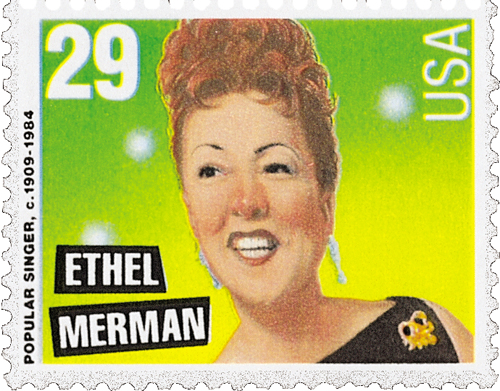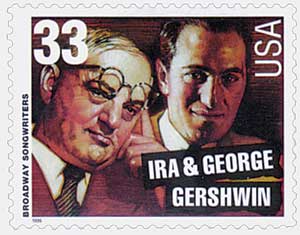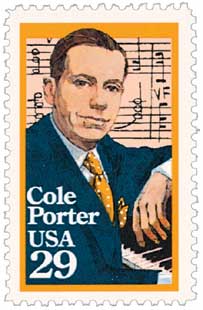
# 2853 FDC - 1994 29c Popular Singers: Ethel Merman
US #2853
1994 Ethel Merman
- From the Popular Singers set
- Part of the Legends of American Music series
- Features five famous singers from the 20th century
Category of Stamp: Commemorative
Set: Legends of American Music series
Value: 29¢
First Day of Issue: September 1, 1994
First Day City: New York, New York
Quantity Issued: 35,436,000
Printed by: Stamp Venturers
Printing Method: Photogravure
Format: Panes of 20, from printing cylinders of 180 subjects (12 across, 15 down)
Perforations: 10.2 X 10.2
Reason the stamp was issued: The Popular Singers stamps were issued as part of the Legends of American Music series. They honor some of the most famous popular singers of the 20th century, including Al Jolson
About the stamp design: Artist and magazine illustrator C.F. Payne was chosen to create the artwork for the Popular Singers stamps. Using photos provided by the USPS, he produced color sketches, then painted the singers using acrylic, watercolor, ink, oil paint, colored pencils, and airbrush.
Special design details: The background colors were chosen to fade into one another to give a sense of continuity to the set.
First Day City: The First Day of Issue ceremony took place at Damrosch Park in New York City. Family members and friends of those honored on the stamps were present at the ceremony. The ceremony also launched the US Postal Service’s month-long American Music Stamp Festival.
Unusual thing about this stamp: During the planning for these stamps, it was decided birth and death dates would be added on the edge of each stamp. After the stamps were issued, Nat “King” Cole’s widow informed the USPS they had the wrong birth date. He had been born in 1919, not 1917 as shown on the stamp. Future stamps in this series don’t contain these dates to avoid another mistake.
About the Legends of American Music Series: The Legends of American Music Series debuted on January 8, 1993, and ran until September 21, 1999. The stamps were issued in semi-jumbo size. The name of each performer is in white letters, sometimes on a black background to make it stand out. The name of the set is shown running up the left side of the stamp.
More than 90 artists are represented from all styles of music: rock ‘n’ roll, rhythm and blues, country and western, jazz and pop, opera and classical, gospel and folk. In addition to individual singers and Broadway musicals, subjects include band leaders, classical composers, Hollywood songwriters and composers, conductors, lyricists, and more. The Legends of American Music Series was a huge advancement for diversity because it honored many Black and female artists.
History the stamp represents:

Ethel Agnes Zimmermann was born on January 16, 1908, in Astoria, Queens, New York. Known as the "Queen of Broadway," her dazzling career lasted more than 50 years.

Merman attended William Cullen Bryant High School, where she trained for secretarial work. She participated in several extracurricular activities including the school's magazine, speakers' club, and student council. Every weekend, her family went to watch vaudeville shows at the Palace Theatre. After graduating, Merman worked as a stenographer during the day and sang at private parties and nightclubs in the evenings. Around this time, she decided to change her name, because it was too long for a theater marquee. She dropped the "Zim" and the final "n" from her name, to become Ethel Merman.

Merman appeared in her first movie in 1930, Paramount's Follow the Leader. That same year, a theater producer saw her performing at the Palace Theatre and convinced her to audition for George and Ira Gershwin's new musical, Girl Crazy. She performed "I Got Rhythm" and they immediate cast her in the role of Kate Fothergill. The play opened to positive reviews in October 1930 and ran for 272 performances. One review said Merman sang "with dash, authority, good voice, and just the right knowing style."

Merman was soon juggling the play and live concerts at three venues, plus she was contracted for 10 short musical films for Paramount. After a very brief vacation, she was hired to help improve George White's Scandals, which ran for 202 performances on Broadway. She then appeared in the musical Take a Chance and the films We're Not Dressing and Kid Millions.
In 1934, Merman appeared in the first five Cole Porter musicals  Anything Goes. Her performance was widely applauded as "vivacious and ingratiating... the embodiment of poise and technical adroitness." Two years later she reprieved her role in the film version of the musical, but it was heavily edited to meet Hollywood guidelines and Merman was unhappy with the final product.
Merman remained busy appearing in several films and Broadway musicals. She was a favored performer for many of the major songwriters of the day, including Irving Berlin, Cole Porter, and Rodgers and Hammerstein. In 1945, Dorothy Fields asked Merman to star in a musical about Annie Oakley. Annie Get Your Gun ran for nearly three years with 1,147 performances. Merman starred in the Broadway revival of the play two decades later.

In 1950, Merman won a Tony Award for her performance in Call Me Madam. And in 1953, she won a Golden Globe for performance in the film adaptation. Merman then took the lead role in Happy Hunting, which ran for 412 performances. In 1959, she took on perhaps her most famous role, as Rose Hovick in Gypsy. After that musical ran for 702 performances, Merman went on a national tour, performing to packed houses despite a back injury. She then appeared in the hit comedy film It's a Mad, Mad, Mad, Mad World, which was the one of the top-grossing films of 1963.

Merman appeared on several television shows including That Girl, The Lucy Show, Match Game, Batman, Tarzan, and more. The musical Hello, Dolly! was composed specifically for Merman to star in, but she turned it down initially. Six years after it opened, she joined the cast and received frequent standing ovations and high praise in her reviews. The play closed in December 1970 and was Merman's final Broadway show. She recorded an album of her classic songs set to a disco beat in the 1970s. In 1972, Merman was awarded a special Tony Award in recognition of her lifetime contribution to show business.
Merman suffered from brain cancer in her later years and died on February 15, 1984. That night, all the lights on Broadway were dimmed in her honor.
US #2853
1994 Ethel Merman
- From the Popular Singers set
- Part of the Legends of American Music series
- Features five famous singers from the 20th century
Category of Stamp: Commemorative
Set: Legends of American Music series
Value: 29¢
First Day of Issue: September 1, 1994
First Day City: New York, New York
Quantity Issued: 35,436,000
Printed by: Stamp Venturers
Printing Method: Photogravure
Format: Panes of 20, from printing cylinders of 180 subjects (12 across, 15 down)
Perforations: 10.2 X 10.2
Reason the stamp was issued: The Popular Singers stamps were issued as part of the Legends of American Music series. They honor some of the most famous popular singers of the 20th century, including Al Jolson
About the stamp design: Artist and magazine illustrator C.F. Payne was chosen to create the artwork for the Popular Singers stamps. Using photos provided by the USPS, he produced color sketches, then painted the singers using acrylic, watercolor, ink, oil paint, colored pencils, and airbrush.
Special design details: The background colors were chosen to fade into one another to give a sense of continuity to the set.
First Day City: The First Day of Issue ceremony took place at Damrosch Park in New York City. Family members and friends of those honored on the stamps were present at the ceremony. The ceremony also launched the US Postal Service’s month-long American Music Stamp Festival.
Unusual thing about this stamp: During the planning for these stamps, it was decided birth and death dates would be added on the edge of each stamp. After the stamps were issued, Nat “King” Cole’s widow informed the USPS they had the wrong birth date. He had been born in 1919, not 1917 as shown on the stamp. Future stamps in this series don’t contain these dates to avoid another mistake.
About the Legends of American Music Series: The Legends of American Music Series debuted on January 8, 1993, and ran until September 21, 1999. The stamps were issued in semi-jumbo size. The name of each performer is in white letters, sometimes on a black background to make it stand out. The name of the set is shown running up the left side of the stamp.
More than 90 artists are represented from all styles of music: rock ‘n’ roll, rhythm and blues, country and western, jazz and pop, opera and classical, gospel and folk. In addition to individual singers and Broadway musicals, subjects include band leaders, classical composers, Hollywood songwriters and composers, conductors, lyricists, and more. The Legends of American Music Series was a huge advancement for diversity because it honored many Black and female artists.
History the stamp represents:

Ethel Agnes Zimmermann was born on January 16, 1908, in Astoria, Queens, New York. Known as the "Queen of Broadway," her dazzling career lasted more than 50 years.

Merman attended William Cullen Bryant High School, where she trained for secretarial work. She participated in several extracurricular activities including the school's magazine, speakers' club, and student council. Every weekend, her family went to watch vaudeville shows at the Palace Theatre. After graduating, Merman worked as a stenographer during the day and sang at private parties and nightclubs in the evenings. Around this time, she decided to change her name, because it was too long for a theater marquee. She dropped the "Zim" and the final "n" from her name, to become Ethel Merman.

Merman appeared in her first movie in 1930, Paramount's Follow the Leader. That same year, a theater producer saw her performing at the Palace Theatre and convinced her to audition for George and Ira Gershwin's new musical, Girl Crazy. She performed "I Got Rhythm" and they immediate cast her in the role of Kate Fothergill. The play opened to positive reviews in October 1930 and ran for 272 performances. One review said Merman sang "with dash, authority, good voice, and just the right knowing style."

Merman was soon juggling the play and live concerts at three venues, plus she was contracted for 10 short musical films for Paramount. After a very brief vacation, she was hired to help improve George White's Scandals, which ran for 202 performances on Broadway. She then appeared in the musical Take a Chance and the films We're Not Dressing and Kid Millions.
In 1934, Merman appeared in the first five Cole Porter musicals  Anything Goes. Her performance was widely applauded as "vivacious and ingratiating... the embodiment of poise and technical adroitness." Two years later she reprieved her role in the film version of the musical, but it was heavily edited to meet Hollywood guidelines and Merman was unhappy with the final product.
Merman remained busy appearing in several films and Broadway musicals. She was a favored performer for many of the major songwriters of the day, including Irving Berlin, Cole Porter, and Rodgers and Hammerstein. In 1945, Dorothy Fields asked Merman to star in a musical about Annie Oakley. Annie Get Your Gun ran for nearly three years with 1,147 performances. Merman starred in the Broadway revival of the play two decades later.

In 1950, Merman won a Tony Award for her performance in Call Me Madam. And in 1953, she won a Golden Globe for performance in the film adaptation. Merman then took the lead role in Happy Hunting, which ran for 412 performances. In 1959, she took on perhaps her most famous role, as Rose Hovick in Gypsy. After that musical ran for 702 performances, Merman went on a national tour, performing to packed houses despite a back injury. She then appeared in the hit comedy film It's a Mad, Mad, Mad, Mad World, which was the one of the top-grossing films of 1963.

Merman appeared on several television shows including That Girl, The Lucy Show, Match Game, Batman, Tarzan, and more. The musical Hello, Dolly! was composed specifically for Merman to star in, but she turned it down initially. Six years after it opened, she joined the cast and received frequent standing ovations and high praise in her reviews. The play closed in December 1970 and was Merman's final Broadway show. She recorded an album of her classic songs set to a disco beat in the 1970s. In 1972, Merman was awarded a special Tony Award in recognition of her lifetime contribution to show business.
Merman suffered from brain cancer in her later years and died on February 15, 1984. That night, all the lights on Broadway were dimmed in her honor.














